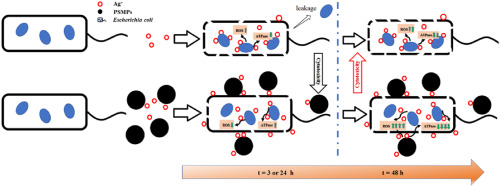当前位置:
X-MOL 学术
›
Chemosphere
›
论文详情
Our official English website, www.x-mol.net, welcomes your
feedback! (Note: you will need to create a separate account there.)
Mechanism of low concentrations of polystyrene microplastics influence the cytotoxicity of Ag ions to Escherichia coli.
Chemosphere ( IF 8.1 ) Pub Date : 2020-04-08 , DOI: 10.1016/j.chemosphere.2020.126705 Caiyun Sun 1 , Weicheng Zhang 2 , Runrun Ding 2 , Jianzheng Wang 3 , Lunguang Yao 2
Chemosphere ( IF 8.1 ) Pub Date : 2020-04-08 , DOI: 10.1016/j.chemosphere.2020.126705 Caiyun Sun 1 , Weicheng Zhang 2 , Runrun Ding 2 , Jianzheng Wang 3 , Lunguang Yao 2
Affiliation

|
Polystyrene microplastics (PSMPs) with different sizes, surface charges and aging statuses simulated field PSMPs and were applied to understand their cytotoxicity to Escherichia coli. The PSMPs hardly affected the viability, membrane integrity, ROS generation and ATPase activity of E. coli, and the cytotoxicity of field PSMPs is marginal and assumed to be overestimated. Low concentrations (1.0 mg L-1) of PSMPs dynamically affect the cytotoxicity of Ag+ to E. coli through various toxic mechanisms. PSMPs likely mitigated the cytotoxicity of Ag+ during the initial 24 h of co-exposure by protecting the cell membrane, inhibiting ROS generation and/or recovering ATPase activity (p < 0.05 or p < 0.01). During prolonged co-exposure for 48 h, nonfunctionalized polystyrene (PS-NF) still mitigated the cytotoxicity of Ag+ by protecting the integrity of the cell membrane, and aged PS-NF slightly affected cytotoxicity. PS-NH2 and PS-COOH intensified the cytotoxicity of Ag+ because PS markedly promoted ROS generation and inhibited ATPase activity. Thus, field PSMPs were assumed to exhibit marginal cytotoxicity to E. coli and can combine with surrounding Ag+ to modify the E. coli population levels and even the structure of aquatic ecosystems. Accordingly, the environmental and health risks of field PSMPs require further intensive investigation, and the combined toxicity effects of field PSMPs with Ag+ should be considered carefully due to their dynamic toxic effects and mechanisms.
中文翻译:

低浓度的聚苯乙烯微塑料的作用机制会影响银离子对大肠杆菌的细胞毒性。
具有不同尺寸,表面电荷和老化状态的聚苯乙烯微塑料(PSMP)可以模拟现场PSMP,并用于了解其对大肠杆菌的细胞毒性。PSMPs几乎不会影响大肠杆菌的生存力,膜完整性,ROS生成和ATPase活性,并且野外PSMPs的细胞毒性很小,因此被高估了。低浓度(1.0 mg L-1)的PSMP通过各种毒性机制动态影响Ag +对大肠杆菌的细胞毒性。PSMPs可能通过保护细胞膜,抑制ROS生成和/或恢复ATPase活性而在共同暴露的最初24小时内减轻Ag +的细胞毒性(p <0.05或p <0.01)。长时间共暴露48小时 非功能化聚苯乙烯(PS-NF)仍通过保护细胞膜的完整性来减轻Ag +的细胞毒性,而老化的PS-NF则对细胞毒性有轻微影响。PS-NH2和PS-COOH增强了Ag +的细胞毒性,因为PS显着促进了ROS的生成并抑制了ATPase的活性。因此,假定野外PSMP对大肠杆菌表现出微弱的细胞毒性,并且可以与周围的Ag +结合以修饰大肠杆菌种群水平,甚至改变水生生态系统的结构。因此,野外PSMP的环境和健康风险需要进一步深入研究,并且野外PSMP的动态毒性作用和机理应仔细考虑野外PSMP与Ag +的联合毒性作用。PS-NH2和PS-COOH增强了Ag +的细胞毒性,因为PS显着促进了ROS的产生并抑制了ATPase的活性。因此,假定野外PSMP对大肠杆菌表现出微弱的细胞毒性,并且可以与周围的Ag +结合以修饰大肠杆菌种群水平,甚至改变水生生态系统的结构。因此,野外PSMP的环境和健康风险需要进一步深入研究,并且野外PSMP的动态毒性作用和机理应仔细考虑野外PSMP与Ag +的联合毒性作用。PS-NH2和PS-COOH增强了Ag +的细胞毒性,因为PS显着促进了ROS的产生并抑制了ATPase的活性。因此,假定野外PSMP对大肠杆菌表现出微弱的细胞毒性,并且可以与周围的Ag +结合以修饰大肠杆菌种群水平,甚至改变水生生态系统的结构。因此,野外PSMPs的环境和健康风险需要进一步深入研究,并且野外PSMPs与Ag +的联合毒性作用应因其动态毒性作用和机理而予以谨慎考虑。
更新日期:2020-04-08
中文翻译:

低浓度的聚苯乙烯微塑料的作用机制会影响银离子对大肠杆菌的细胞毒性。
具有不同尺寸,表面电荷和老化状态的聚苯乙烯微塑料(PSMP)可以模拟现场PSMP,并用于了解其对大肠杆菌的细胞毒性。PSMPs几乎不会影响大肠杆菌的生存力,膜完整性,ROS生成和ATPase活性,并且野外PSMPs的细胞毒性很小,因此被高估了。低浓度(1.0 mg L-1)的PSMP通过各种毒性机制动态影响Ag +对大肠杆菌的细胞毒性。PSMPs可能通过保护细胞膜,抑制ROS生成和/或恢复ATPase活性而在共同暴露的最初24小时内减轻Ag +的细胞毒性(p <0.05或p <0.01)。长时间共暴露48小时 非功能化聚苯乙烯(PS-NF)仍通过保护细胞膜的完整性来减轻Ag +的细胞毒性,而老化的PS-NF则对细胞毒性有轻微影响。PS-NH2和PS-COOH增强了Ag +的细胞毒性,因为PS显着促进了ROS的生成并抑制了ATPase的活性。因此,假定野外PSMP对大肠杆菌表现出微弱的细胞毒性,并且可以与周围的Ag +结合以修饰大肠杆菌种群水平,甚至改变水生生态系统的结构。因此,野外PSMP的环境和健康风险需要进一步深入研究,并且野外PSMP的动态毒性作用和机理应仔细考虑野外PSMP与Ag +的联合毒性作用。PS-NH2和PS-COOH增强了Ag +的细胞毒性,因为PS显着促进了ROS的产生并抑制了ATPase的活性。因此,假定野外PSMP对大肠杆菌表现出微弱的细胞毒性,并且可以与周围的Ag +结合以修饰大肠杆菌种群水平,甚至改变水生生态系统的结构。因此,野外PSMP的环境和健康风险需要进一步深入研究,并且野外PSMP的动态毒性作用和机理应仔细考虑野外PSMP与Ag +的联合毒性作用。PS-NH2和PS-COOH增强了Ag +的细胞毒性,因为PS显着促进了ROS的产生并抑制了ATPase的活性。因此,假定野外PSMP对大肠杆菌表现出微弱的细胞毒性,并且可以与周围的Ag +结合以修饰大肠杆菌种群水平,甚至改变水生生态系统的结构。因此,野外PSMPs的环境和健康风险需要进一步深入研究,并且野外PSMPs与Ag +的联合毒性作用应因其动态毒性作用和机理而予以谨慎考虑。











































 京公网安备 11010802027423号
京公网安备 11010802027423号